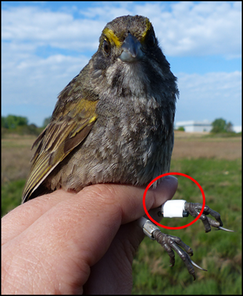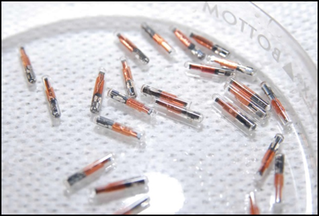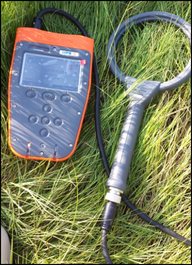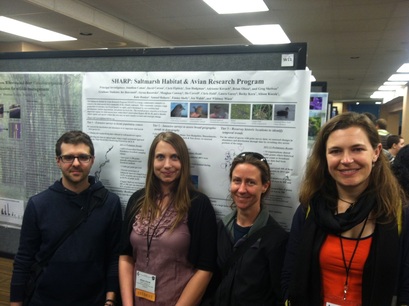 Adult Seaside Sparrow in NY with a passive integrative transponder (PIT) tag attached to a color band on its left leg.
Adult Seaside Sparrow in NY with a passive integrative transponder (PIT) tag attached to a color band on its left leg. Alison and fellow researchers applied tags (using epoxy and electrical tape) to the color bands of female saltmarsh sparrows (ME and NY), Nelson’s Sparrows (ME) and hybrids (ME), and male and female seaside sparrows (NY) captured throughout the 2014 field season. She also banded male seaside sparrows with PIT tags because they are known to occasionally aid in feeding young and are notoriously difficult to capture during targeted netting at nests. Tags were applied to 88 individuals in New York and 84 in Maine. Once several individuals were tagged at a study site, researchers began placing RFID (Radio Frequency Identification) reader antennae next to active nests for 15-minute intervals to determine which individuals were attending nests. To confirm that RFID readers were only capturing the IDs of the attending adult and not another bird passing by, a subset of these same nests were later targeted for netting. In all instances where targeted netting resulted in a capture, individuals trapped in nets were the same individuals whose PIT tag ID was recorded by the RFID reader at the nest. Also, in every instance that an RFID Reader was unable to obtain the PIT tag ID of an individual, target netting determined that the attending individual was not marked with a PIT Tag. Thus, these data demonstrated 100% PIT tag readability and accuracy during the 2014 field season in both New York and Maine.
Alison plans to continue this work in 2015, and will tag new individuals as well as examine return and retention rates for previously tagged birds. Alison and Dr. Cohen conduct this research as part of the Salt Marsh Habitat and Avian Research Program (SHARP), a collaborative effort among several universities and agencies in the Eastern U.S. SUNY ESF’s portion of the project is funded by the U.S. Fish and Wildlife Service's Hurricane Sandy recovery program.



 RSS Feed
RSS Feed
